
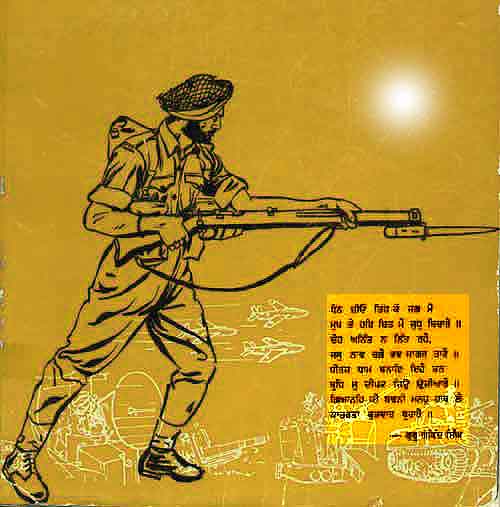
The following historical facts have been taken with courtesy of BHARAT RAKSHAK.COM
LANCE NAIK KARAM SINGH
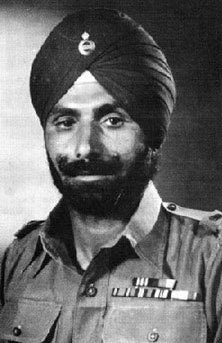
Lance Naik Karam Singh was born on 15 September 1915, in Barnala,
Punjab. He was enrolled in 1 Sikh on 15 September 1941. He had earned a Military
Medal in World War II. During the Jammu & Kashmir operations in the summer
of 1948 the Indian Army made substantial gains in the Tithwal sector. The
led to the capture of Tithwal of 23 May 1948. The enemy fled in utter confusion
across the Kishanganga after dumping their arms and equipment in the river.
But the enemy quickly recovered from this shock. They re-organised their forces
and mounted a strong counter-attack to recover the lost ground. As a result,
the Indian Army could not withstand the enemy pressure and withdrew from their
positions across the Kishanganga river. Finally, they settled on the Tithwal
ride to take on the enemy.
The battle of Tithwal went on for months. The enemy could not, however, make
a dent on the Indian defences. On October 13th, they launched a desperate
attack in brigade strength to evict the Indian Army from their strongly held
positions. The objective was to recapture Richhmar Gali to the south of Tithwal
and to outflank the Indian Army by marching on to Nastachur Pass to the east
of Tithwal. Both attempts failed. During this attack, some bitter fighting
took place in the Richhmar Gali area on the night of October 13th. The attack
commenced with heavy shelling of guns and mortar. The fire was so devastating
that nearly all bunkers in the platoon area were damaged. In this action the
1 Sikh played a very important role in beating back the enemy onslaught. Lance
Naik Karam Singh was commanding a forward outpost when the enemy launched
the attack. His post was attacked by the enemy in vastly superior strength.
The outpost was attacked eight times and the Sikhs repulsed the enemy every
time. When ammunition ran short, Lance Naik Karam Singh joined the main company
position, knowing fully well that due to the heavy enemy shelling no help
would be forthcoming. Although himself wounded, he brought back two injured
comrades with the help of a third mate.
Ringed by enemy fire, it was almost impossible for them to break out. Ignoring
all dangers, he crawled from place to place encouraging his men to keep up
the fight. Often he beat back the enemy with grenades. Twice wounded, he refused
evacuation and continued to hold on to the first-line trenches. The fifth
enemy attack was very intense. Two enemy soldiers came so close to his position
that he could not engage them without hitting his men. Lance Naik Karam Singh,
jumped out of his trench and bayoneted the two intruders to death. This bold
action so demoralised the enemy that they broke off the attack. Three more
enemy attacks which followed were also repulsed by Lance Naik Karam Singh
and his men. Lance Naik Karam Singh was an inspiration to his comrades and
a threat to the enemy. He was honoured with the highest wartime gallantry
medal, Param Vir Chakra, for his outstanding role in the battle of
Tithwal.
SUBEDAR JOGINDER SINGH
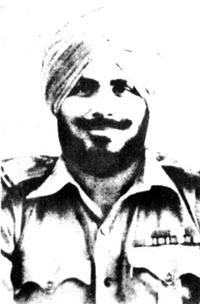
Subedar Joginder Singh, was born on 26 September 1921, in Faridkot,
Punjab. On 28 September 1936, he was enrolled in the 1 Sikh Regiment. During
the 1962 Indo-China War, Subedar Joginder Singh commanded a platoon in the
Tawang sector of NEFA (North East Frontier Agency). While holding a defensive
position on a ridge in Tongpeng La area on Bum La axis, the platoon noticed
heavy enemy concentration opposite Bum La across the McMohan Line on October
20th. This was indeed a preparatory to the Chinese advance on Bum La axis
on October 23rd.
At 0530 hours on October 23rd, the Chinese launched a heavy attack on the
Bum La axis. The intention was to achieve a breakthrough to Tawang. The enemy
attacked the Ridge in three waves, each about 200 strong. The attack was supported
by artillery and mortar fire, besides other weapons. The fierce resistance
of the Sikh platoon, however, compelled the enemy to fall back with heavy
losses. But he regrouped quickly and launched a fresh attack under the cover
of an artillery barrage. However, Subedar Joginder Singh and his platoon stood
firm like a rock before the advancing enemy. In this fierce action, the platoon
lost half of its men but not the will to fight. Subedar Joginder Singh, despite
a wound in the thigh, refused evacuation. His platoon also refused to yield
any ground to the enemy. The last wave of the Chinese attack, which was more
determined and more forceful followed next. Now the platoon had very few men
left to fight. Subedar Joginder Singh, therefore, manned a light machine gun
and killed a large number of enemies.
But he could not stem the tide of the enemy advance single-handed. The Chinese
Army continued advancing with little concern for the casualties. By now all
ammunition with the platoon had been exhausted. When the situation became
desperate, Subedar Joginder Singh and his men emerged from their position
with fixed bayonets, shouting the Sikh battle cry, "Wahe Guruji ka Khalsa,
Wahe Guruji ki Fateh." They fell upon the advancing enemy and bayoneted
many to death. Finally better weapons and numerical superiority of the enemy
prevailed and Subedar Singh was killed in this epic battle. For his inspiring
leadership, courage and devotion to duty, Subedar Joginder Singh was awarded
the highest wartime gallantry medal, the Param Vir Chakra, posthumously.
Jai Hind!! Jai Jawan!!
NIRMALJIT SINGH SEKHON
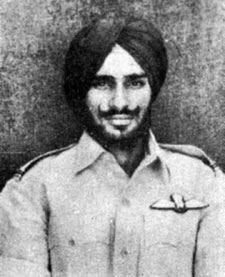
Flying Officer Nirmal Jit Singh Sekhon, son of Warrant Officer
(Hon. Flt. Lt.) Trilok Singh Sekhon, was born on 17 July 1943, in Ludhiana,
Punjab. He was commissioned into the Indian Air Force on 04 June 1967. During
the 1971 Indo-Pak War, Fg. Off. Sekhon was with No.18 Flying Bullets Squadron
flying the Gnat fighter based at Srinagar. In accordance with the international
agreement dating back to 1948, no air defence aircraft were based at Sirinagar,
until the outbreak of hostilities with Pakistan.
Fg. Off. Sekhon was, therefore, unfamiliar with the terrain and was not acclimatised
to the altitude of Srinagar, especially with the bitter cold and biting winds
of the Kashmir winter. Nevertheless, from the onset of the war, he and his
colleagues fought successive waves of intruding Pakistani aircraft with valour
and determination, maintaining the high reputation of the Gnat aircraft. Early
morning on 14 December 1971, Srinagar airfield was attacked by a wave of six
enemy F-86 Sabre aircraft. Flying Officer Sekhon was on readiness duty at
the time. However, he could not take off at once because of the clouds of
dust raised by another aircraft which had just taken off. By the time the
runway was fit for take off, no fewer than six enemy aircraft were overhead,
and strafing of the airfield was in progress.Nevertheless, in-spite of the
mortal danger of attempting to take off during an attack, and in-spite of
the odds against him, he took off and immediately engaged a pair of the attacking
Sabres. He succeeded in damaging two of the enemy aircraft. In the fight that
followed, at tree top height, he all but held his own, but was eventually
overcome by sheer weight of numbers. His aircraft crashed and he was killed.
Sacrificing himself for the defence of Srinagar, Flying Officer Sekhon achieved
his objective - the PAF Sabres fled from the scene of the battle without pressing
home their attack against the town and the airfield. The sublime heroism,
supreme gallantry, flying skill and determination, above & beyond the
call of duty, displayed by Fg. Off. Sekhon in the face of certain death, set
new heights to Air Force traditions. Flying Officer Nirmal Jit Singh Sekhon
was awarded the highest wartime gallantry medal, Param Vir Chakra,
posthumously.
NAIB SUBEDAR BANA SINGH
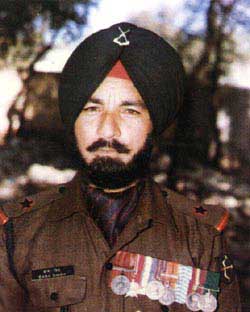
Naib Subedar Bana Singh, born in Kadyal, Jammu on 6 January
1949, was enrolled in the Indian Army on 6 January 1969 into the Jammu &
Kashmir Light Infantry (JAK LI). During June 1987, the 8 JAK LI, was deployed
in the Siachen area. It was then found that a large number of Pakistani infiltrators
had intruded in the Siachen Glacier. The ejection of these infiltrators was
considered difficult but necessary and a special task force was, constituted
for the purpose. Naib Subedar Singh volunteered to join this force.
The Pakistani intrusion had taken place at a height of 6500 metres. The enemy
post was virtually an impregnable glacier fortress with ice walls, 457 metres
high, on either side. Naib Subedar Bana Singh led his men through an extremely
difficult and hazardous route. He inspired them by his courage and leadership.
He and his men crawled and closed in on the adversary. Lobbing hand-grenades,
charging with a bayonet and moving from trench to trench, he cleared the post
of all intruders. Naib Subedar Bana Singh was awarded the Param Vir Chakra,
the highest wartime gallantry medal, for conspicuous bravery and leadership
under most adverse conditions
SARDAR BAHADUR ISHER SINGH
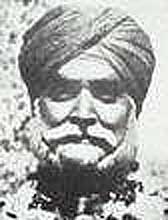
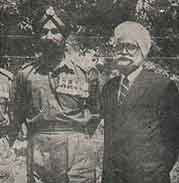 Captain
Ishar Singh was the first Sikh to receive the Victoria Cross in 1921.
He is seen here with General Harbaksh Singh.
Captain
Ishar Singh was the first Sikh to receive the Victoria Cross in 1921.
He is seen here with General Harbaksh Singh.
Sepoy Ishar Singh gained his Victoria Cross on 10 April
1921 in Haidar Kach (Waziristan) for gallantry and devotion to duty beyond
praise.
When the convoy protection troops were attacked, this Sepoy was No.1 of a
Lewis Gun Section. Early in the action he received a very severe gunshot wound
in his chest and fell beside his Lewis gun. Hand-to-hand fighting being comemnced,
the British office, Indian officer, and all the Havildars of his company were
either killed or wounded, and his Lewis gun was seized by the enemy.
Calling up two other men, he got up, charged the enemy, recovered the Lewis
gun, and, although bleeding profusely, again got the gun into action. When
his Jemadar arrived, he took the gun from Sepoy Ishar Singh and ordered him
to go back and have his wound dressed. Instead of doing this, the Sepoy went
to the medical officer, and was of great assistance in pointing out where
the wounded were, and in carrying water to them.
He made innumerable journeys to the river bank and back for this purpose.
On one occasion, when the enemy fire was very heavy, he took the rifle of
a wounded man and helped to keep down the fire. On another occasion he stood
in front of the medical officer who was dressing a wounded man, thus shielding
him with his own body. It was over three hours before he finally submitted
to be evacuated, being then too weak from loss of blood to object.
"His gallantry and devotion to duty were beyond praise. His conduct inspired
all who saw him." (London Gazette supplement, 25 November 1921) He was
later to be awarded the Order of British India, First Class, which carried
with it the title of "Sardar Bahadur." This joint award of the V.C.
and O.B.I. was unique.
LT. KARAMJEET SINGH JUDGE

Lieutenant Karamjeet Singh Judge, 15 Punjab, was serving in
the Burma Campaign in World War II. While leading his platoon to capture
the enemy post in the outskirts of Myigiyan in Burma, his company came
under heavy fire from enemy MMG and small arms besides intense shelling
by their artillery guns. Due to the stiff enemy resistance, the attack
was getting help up time and again. Undaunted and with complete disregard
to his own safety, Lt. Judge personally led the assault and cleared bunker
to bunker in a fierce hand to hand combat. In the process he killed a
number of Japanese soldiers before he was mortally wounded by an LMG burst
on his chest.
Lt. Judge by his exceptional courage and bravery of the highest order
against the heaviest of odds, enabled successful capture of the objective
and in the process made the supreme sacrifice. The raw courage and valour
displayed by Lt. Judge in the highest traditions of Infantry will go down
as a glorious chapter in the history of the Indian Army. For this achievement,
Lt. Judge was awarded the Victoria Cross, Britain's highest medal
for gallantry.
PORTRAITS OF COURAGE
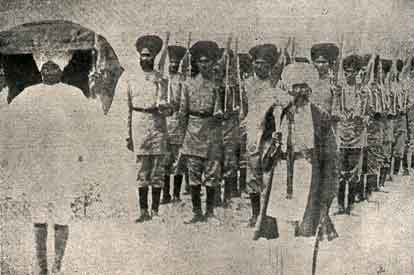
Sikh Regiment off to War with blessings from the Holy Granth Sahib and Ardass by the Granthis.
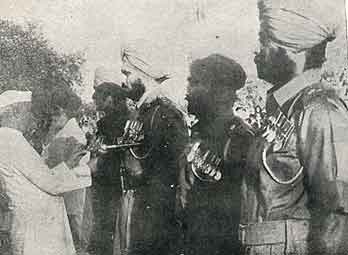
After 1947--Prime Minister Nehru with the Sikh battalion.
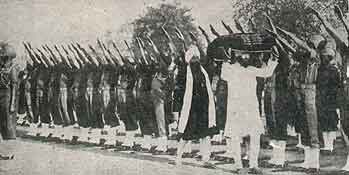
The swearing in ceremony of the Sikh army during the first Kashmir war with Pakistan.
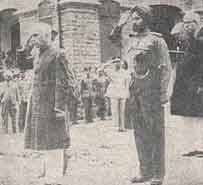
Prime Minister Nehru and Major General Rajinder Singh take a salute on 7th Nov 1947, during the Kashmir War.
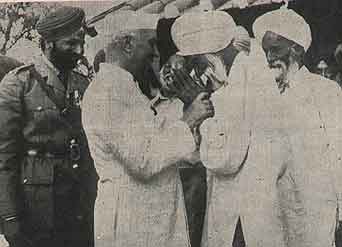
Prime Minister Mr. Nehru meeting some old warriors
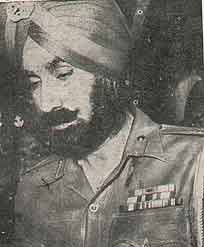
Padama Bhooshan and Veer Chakra Vijayta Lt.Gen. Harbaksh Singh
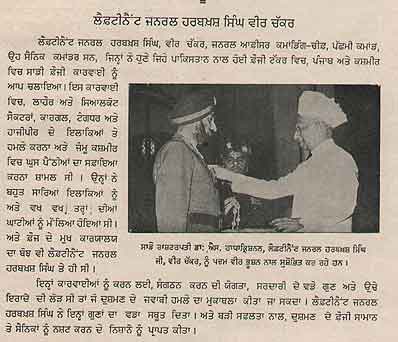
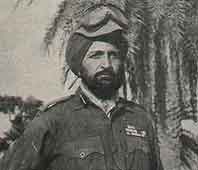
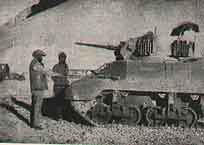
Major General Rajinder Singh with a tank in Zojila in 1948, where he fought very bravely and destroyed 609 enemy (Pakistani) tanks.
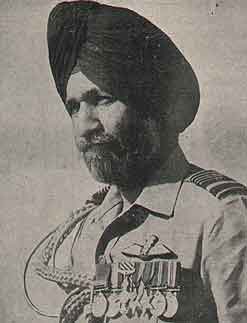
Padam Vibhushan, Air Marshall Arjan Singh D.F.C. whose bravery in air has been second to none.
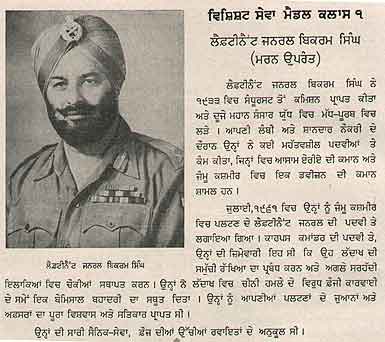
Lt. General Bikram Singh
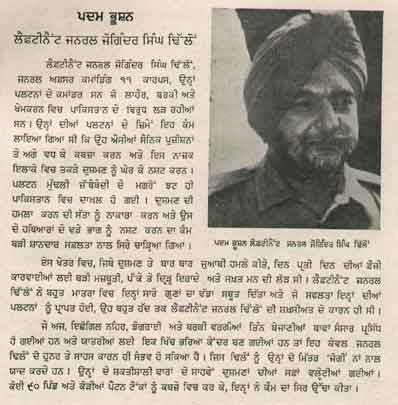
Lt. General Joginder Singh Dhillon
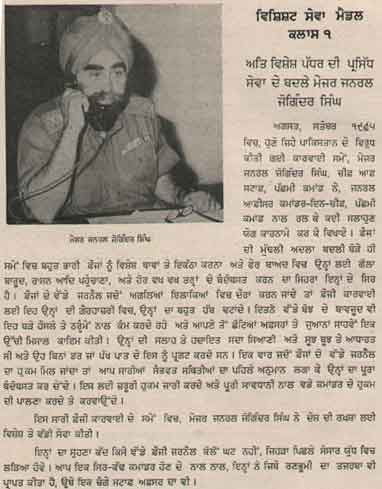
Major General Joginder Singh
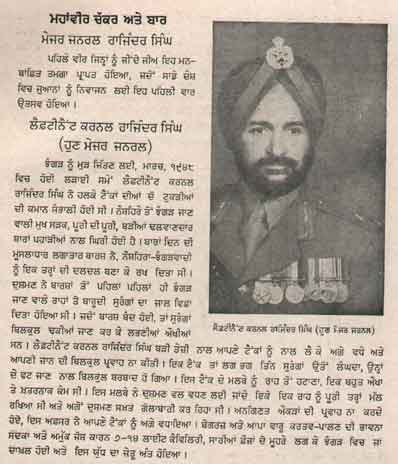
Major General Joginder Singh
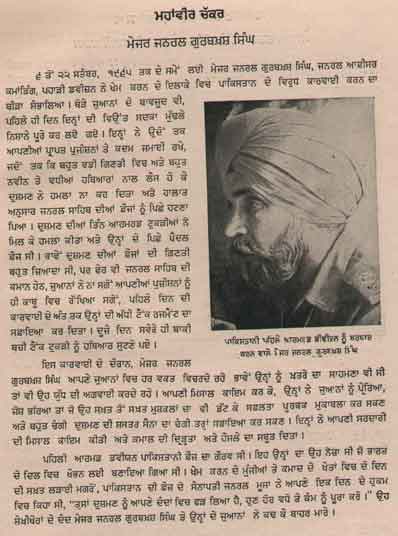
Major General Gurbaksh Singh
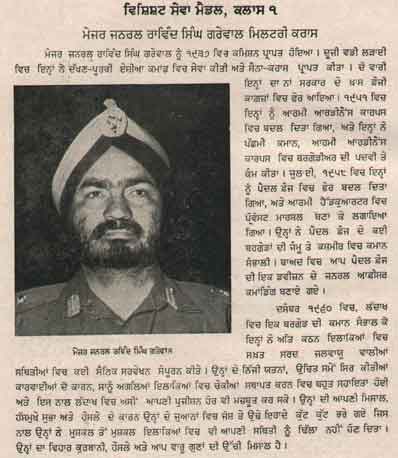
Major General Ravind Singh
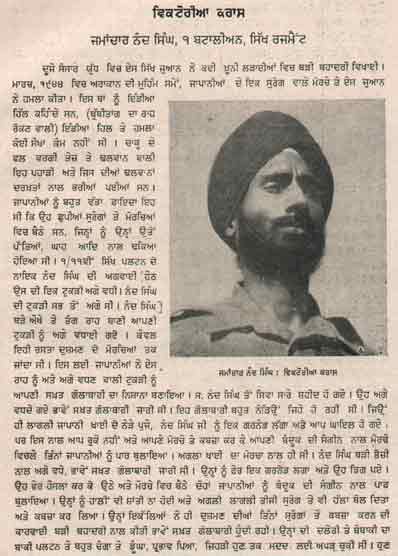
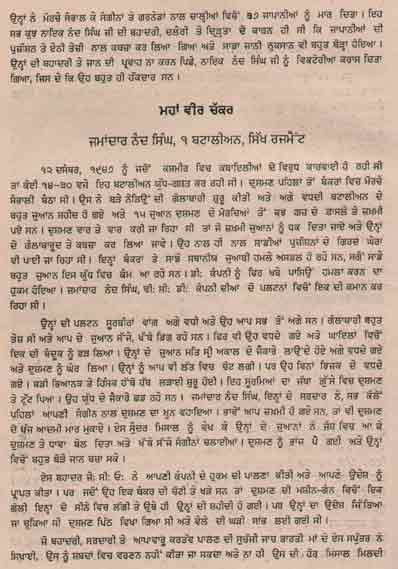

VICTORIA CROSS winner Jamadar Nand Singh
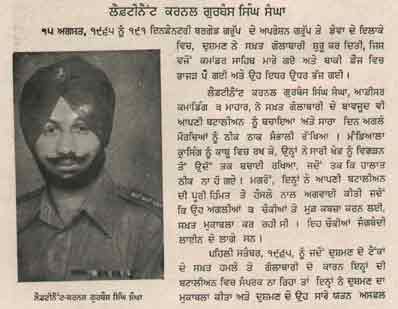

MahaVeer Chakra Lt. General Gurbans Singh Sangha

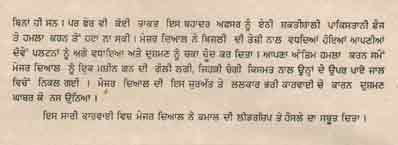
Maha Veer Chakra Lt. Col. Ranjit Singh Dyal
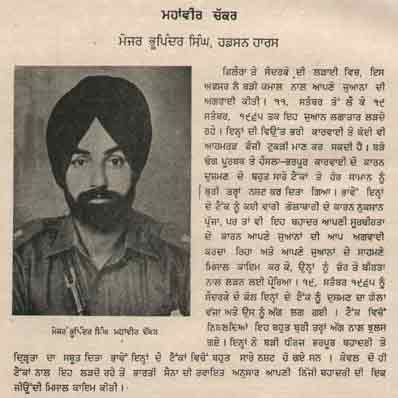
Maha Veer Chakra Major Bhupinder Singh Hudson Horse
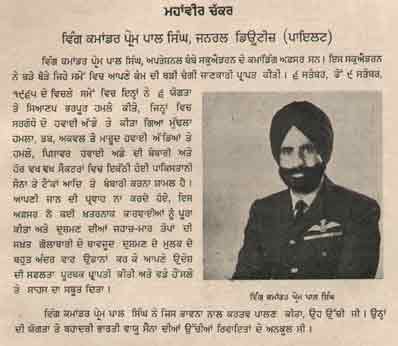
Maha Veer Chakra Wing Commander Prem Pal Singh
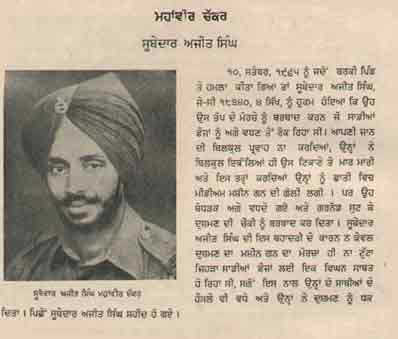
Maha Veer Chakra Subedar Ajit Singh
DEFENDING SARAGARHI, 12 SEPTEMBER 1897
Sources: Sainik Samachar and Sikh Review
By : L.N. Subramanian…a South Indian
INTRODUCTION
Saragarhi is the incredible story of 21 men of the 36th Sikh Regiment (currently the 4th Sikh Regiment) who gave up their lives in devotion to their duty. In keeping with the tradition of the Indian Army, they fought to the death rather than surrender. The Battle at Saragarhi is one of eight stories of collective bravery published by UNESCO (United Nations Educational, Scientific and Cultural Organization). It has been mentioned as one of the five most significant events of its kind in the world which includes the Saga of Thermoplyae associated with the heroic stand of a small Greek force against the mighty Persian Army of Xerxes in 480 B.C.
THE BATTLE
The British colonial rulers had constructed a series of forts to control the NWFP (North West Frontier Province - today a state in Pakistan) and to provide security to troops against marauding tribesmen and their lashkars (large body of troops). Most of these forts had initially been built by Maharaja Ranjit Singh as part of the consolidation of the Sikh empire in Punjab and the British added some more. The British had only partially succeeded in gaining control over this region, consequently, skirmishes and sometimes serious fights with the tribals were a frequent occurrence. However, the NWFP was a good training ground for the Indian Army to hone its skills and techniques.
Two such forts on the Samana ridge of the Hindukush & Sulaiman ranges that is Fort Lockhart and Fort Gulistan were a few miles apart. Since these forts were not inter-visible, a signalling relay post called Saragarhi was located mid-way on a bluff to provide heliographic communications between them. This post or picket had been fortified to provide safety and protection to the signaling detachment. In 1897 there was a general uprising in the NWFP engineered by Afghans as part of their policy, which came to be known as the 'prickly heat policy' to direct the wrath of the tribals against the British. In this uprising, Mullahs (Muslim religious leaders) played a prominent role. It was the duty of the 36th Sikh to occupy Gulistan and Lockhart forts. On 3rd and 9th September 1897, Orakazai and Afridi lashkars
attacked Fort Gulistan. On both occasion the attacks were beaten back. A relief column was sent from the fort to assist in beating back these attacked.
The relief column from Lockhart on the return trip reinforced the signaling detachment at Saragarhi making its strength to 1 NCO (Non-Commissioned Officer) and 20 ORs (Other Ranks). In a renewed effort, on 12 September 1897, hordes of tribesmen laid siege to Fort Lockhart and Saragarhi, with the aim of overrunning the latter and at the same time preventing any help from the former. The Commanding Officer of 36th Sikh, Lt. Col. Haughton, was at Fort Lockhart and was in communication with the Saragarhi post through helicograph. The defenders of Saragarhi under the indomitable and inspiring leadership of their detachment commander, Havildar Ishar Singh, resolved to defend their post in the best tradition of their race and regiment. They were not there to hand over the post to the enemy and seek safety elsewhere. Havildar Singh and his men knew well that the post would fall, because a handful of men in that make-shift fort of stones & mud walls with a wooden door could not stand the onslaught of thousands of tribesmen. These plucky men knew that they will go down but they had resolved to do so fighting to the last. From Fort Lockhart, troops and the Commanding Officer could count at least 14 standards and that gave an idea of the number of tribes and their massed strength against the Saragarhi relay post (estimated at between 10,000 to 12,000 tribals). From early morning the tribals started battering the fort.
The Sikhs fought back valiantly. Charge after charge was repulsed by the men of the 36th Sikh. The tribal leaders started to make tempting promises so that the Sikhs would surrender. But Havildar Singh and his men ignored them.
For quite some time, the troops held their own against the determined and repeated attacks by the wild and ferocious hordes. A few attempts were made to send a relief column from Fort Lockhart but these were foiled by the tribes. At Saragarhi, the enemy made two determined attempts to rush the gate of the post and on both occasions the defenders repulsed the assault. While the enemy suffered heavy casualties, the ranks of the defenders too kept dwindling as the fire from the attackers took its toll and their ammunition stocks were depleting. Unmindful of his safety, Sepoy Gurmukh Singh kept signaling a minute-to-minute account of the battle from the signal tower in the post to Battalion HQs. The battle lasted the better part of the day. When repeated attacks failed, the enemy set fire to the surrounding bushes & shrubs and two of the tribesmen under cover of smoke, managed to close in with the post's boundary wall in an area blind to the defender's observation and rifle fire from the post holes. They succeeded in making a breach in the wall. This development could be seen from Fort Lockhart and was flashed
to the post.
A few men from those defending the approaches to the gate were dispatched to deal with the breach in the wall. This diversion by the enemy and the defenders' reaction resulted in weakening of the fire covering the gate. The enemy now rushed the gate as well as the breach. Thereafter, one of the fiercest hand-to-hand fights followed. One of the Havildar Singh's men, who was seriously wounded and was profusely bleeding, had taken charge of the guardroom. He shot four of the enemy as they tried to approach his charge. All this time, Sepoy Gurmukh Singh continued flashing the details of the action at the post. Beside this the Commanding Officer of 36th Sikh and others at Lockhart Fort also saw his unique saga of heroism and valor unfolds at Saragarhi. The battle had come too close for Sepoy Gurmukh
Singh's comfort, so he asked Battalion HQs for permission to shut down the heliograph and take up his rifle. Permission was flashed back. He dismounted his heliograph equipment, packed it in a leather bag, fixed bayonet on his rifle and joined the fight. From this vantage point in the tower he wrought havoc on the intruders in the post. He died fighting, but took 20 of the enemy with him. The tribes set fire to the post, while the brave garrison lay dead or dying with their ammunition exhausted. Next morning the relief column reached the post and the tell tale marks of the epic fight were there for all to see. The tribes later admitted to figure of 180 dead and many more wounded. This episode when narrated in the British Parliament, drew from the members a standing ovation in the memory of the defenders of Saragarhi. The story of the heroic deeds of these men was also placed before Queen Victoria. The account was received all over the world with awe and admiration. All the 21 valiant men of this epic battle were awarded the Indian Order of Merit Class III (posthumously) which at the time was one of the highest gallantry awards given to Indian troops and is considered equivalent to the present-day Vir Chakra. All dependants of the Saragarhi heroes were awarded 50 acres of land and 500 Rupees. Never before or since has a body of troops - that is, all of them won gallantry awards in a single action. It is indeed a singularly unique action in the annals of Indian military history.
A tablet erected in the memory of these brave men. The tablet reads;
"The Government of India have caused this tablet to be erected to the memory of the twenty one non-commissioned officers and men of the 36 Sikh Regiment
of the Bengal Infantry whose names are engraved below as a perpetual record of the heroism shown by these gallant soldiers who died at their posts in the defence of the fort of Saragarhi, on the 12 September 1897, fighting against overwhelming numbers, thus proving their loyalty and devotion to their sovereign, the Queen Empress of India, and gloriously maintaining the reputation of the Sikhs for unflinching courage on the field of battle."
> > 165 Havildar Ishar Singh
> > 332 Naik Lal Singh 834 Sepoy Narayan Singh
> > 546 Lance Naik Chanda Singh 814 Sepoy Gurmukh Singh
> > 1321 Sepoy Sundar Singh 871 Sepoy Jivan Singh
> > 287 Sepoy Ram Singh 1733 Sepoy Gurmukh Singh
> > 492 Sepoy Uttar Singh 163 Sepoy Ram Singh
> > 182 Sepoy Sahib Singh 1257 Sepoy Bhagwan Singh
> > 359 Sepoy Hira Singh 1265 Sepoy Bhagwan Singh
> > 687 Sepoy Daya Singh 1556 Sepoy Buta Singh
> > 760 Sepoy Jivan Singh 1651 Sepoy Jivan Singh
> > 791 Sepoy Bhola Singh 1221 Sepoy Nand Singh